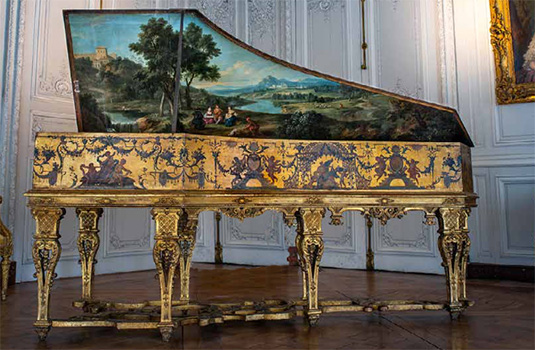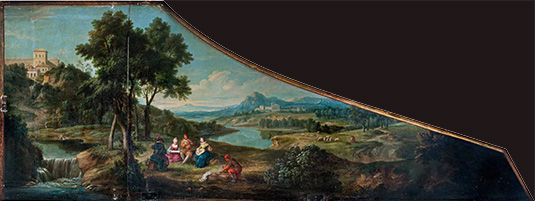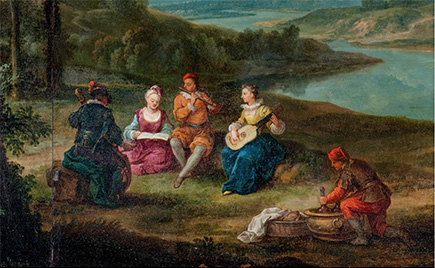
- Home Page
- Accepted
Paintings & Copies - Doubtful
Attributions - Doubtful Textual References
- Alternative
Titles - Collectors &
Museums - Bibliography
- Search Abecedario
- Watteau &
His Circle
X. Clavecin de Ruckers
Entered May 2023

Versailles, château, inv. Vmb 14382
Oil on panel
Measurements unknown
PROVENANCE
Paris, Mme de André, “un clavecin de Ruckers, peint par Watteau.” Listed for sale in Annonces, affiches & avis divers, March 11, 1756, p. 165.
Paris, collection of Joseph-Fernand Boissard de Boisdenier (1813-1866; artist). Donated to the Musée de Thermes et hôtel de Cluny, Paris.
Transferred to Versailles in 1946.
SELECT BIBLIOGRAPHY
Dacier, Vuaflart, and Hérold, Jean de Jullienne et les graveurs, 3: under cat. 206.
Adhémar, Watteau (1950), under cat. 21.
O’Brien, Ruckers (1990).
Anselm, “Le Concert champêtre du clavecin Ioannes Ruckers,” (2019), 1-79.
Tonkovich, Gillot (2023), 222.
REMARKS

Robert Bonnart, harpsichord cover, c. 1690. Versailles, château.
As Dacier and Vuaflart pointed out, a harpsichord belonging to a Madame de André, who lived near the barrière Sainte-Anne, was announced for sale in 1756. It was claimed to be by one of the Ruckers family with painted decoration by Watteau. This was just thirty-five years after the latter’s death, indicating how swiftly his name had become synonymous with decorative, pastoral subjects. While Adhémar repeated Dacier and Vuaflart’s reference to this harpsichord, subsequent Watteau scholars have not. Ultimately, there is no reason to believe that Watteau painted a harpsichord built by a member of the Ruckers family.
The famous Flemish Ruckers dynasty of harpsichord builders operated from the second half of the sixteenth century into the first years of the eighteenth. Toward the end of the seventeenth century, as musical tastes changed, many of the older instruments were rebuilt and redecorated, which is why so many of the extant examples, although made in the early seventeenth century, bear decoration of the 1680s and later. Presumably Madame de André’s was one of these reworked instruments.

Robert Bonnart, harpsichord cover (detail), c. 1690. Versailles, château.
Anselm has demonstrated that references to such painted harpsichords can be found in nineteenth-century sources. The artist Joseph-Fernand Boissard de Boisdenier (1813-1866), one of a circle of Parisian Romantics who favored the art of the eighteenth century, owned such a harpsichord. He was under the impression that it had been painted by Watteau. Recently his instrument, now in Versailles, was examined and restored, and its attribution reconsidered. Although the main body of the instrument is dated 1628 and was fabricated by Joannes Ruckers, the ornament around the sides is now attributed to Claude III Audran. It was discovered that the landscape on the inner surface of the cover has the partial signature “Bonn,” standing for Robert Bonnart (1652-1733). Certainly the type of genre scene and figural style are aligned with the work of that pre-Watteau generation. Unaware of Madame de André’s claim, Anselm inadvertantly echoed history by postulating that Watteau may have designed this genre scene and that Bonnart then painted it. Such a claim is unjustified. There is no reason to think that Watteau had a hand in designing or executing this pastoral scene.